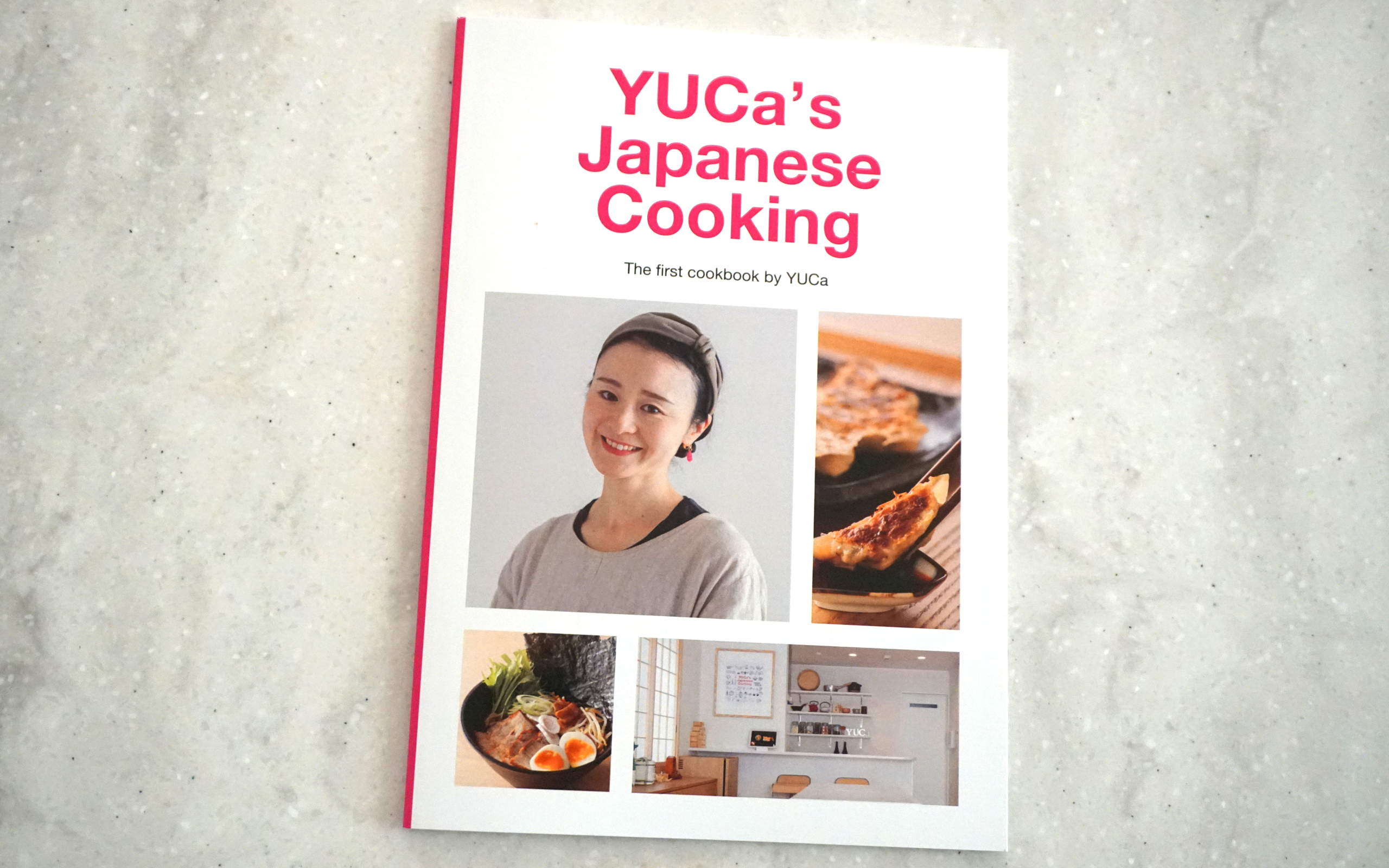Latest Posts
All about Mochi
Mochi (もち、餅) is a polite term for mochi, a food made from glutinous rice. Usually, it is made by steaming glutinous rice and pounding it with a pestle, but it is also widely called mochi when made from grains, rice flour, kuzu flour, and other ingredients. It is a round or flattened food.
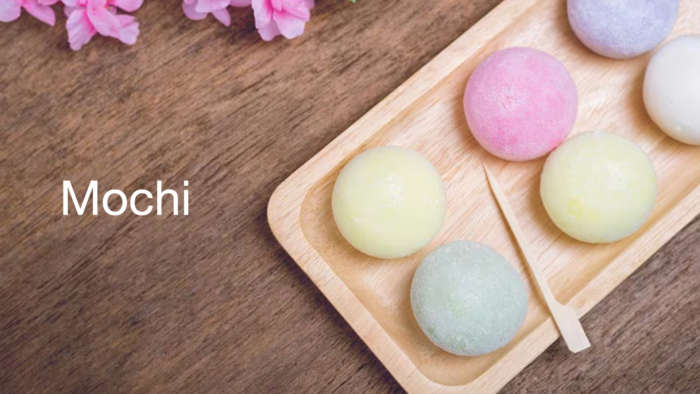
Mochi in foreign countries seems to be widely recognized as a sweet with ice cream.
Mochi are rich in carbohydrates (carbohydrates), which are the main source of energy during exercise; they contain more carbohydrates in 100g than rice.
Many people can eat two or three rice cakes even if they cannot eat a bowl of rice or a bowl of rice. Another excellent point of mochi is that it can be eaten in a variety of ways, such as in soups, wrapped in nori (seaweed), or with daikon radish or natto (fermented soybeans) to take in other nutrients at the same time.
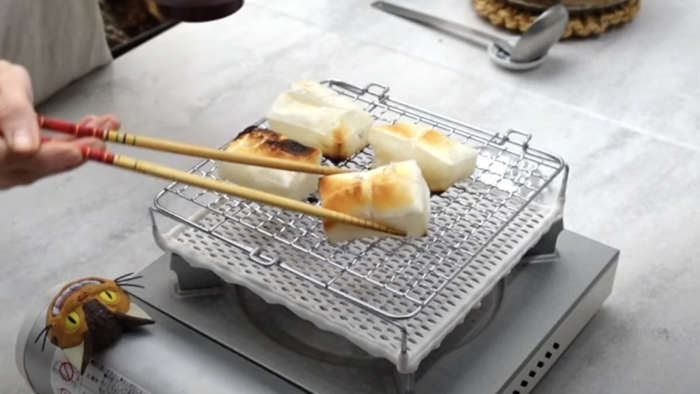
It is believed that the rice cake culture was introduced along with the rice culture. In Japan, in particular, people had a particular preference for the stickiness of mochi, which is said to have led to the creation of a unique mochi culture. It is mentioned in documents from the Nara period (710-794), and at that time it was used as a confectionery for the nobility.
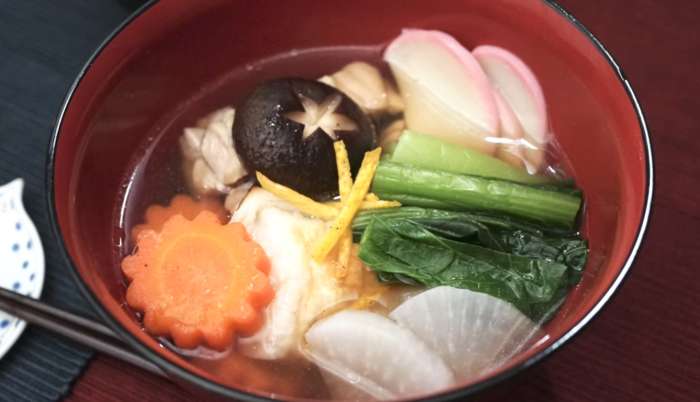
By the Heian period (794-1185), event foods were established and Kagamimochi (mirror-shaped mochi) in January, Hishimochi (rhombus-shaped mochi) in March, and Kashiwa Mochi (mochi wrapped with oak leaf) in May were introduced. Botamochi (adzuki bean mochi) and grilled mochi and mochi sweets became common during the Kamakura period (1185-1333), and became increasingly popular during the Edo period (1603-1868), when mochi sweets were used for annual events.
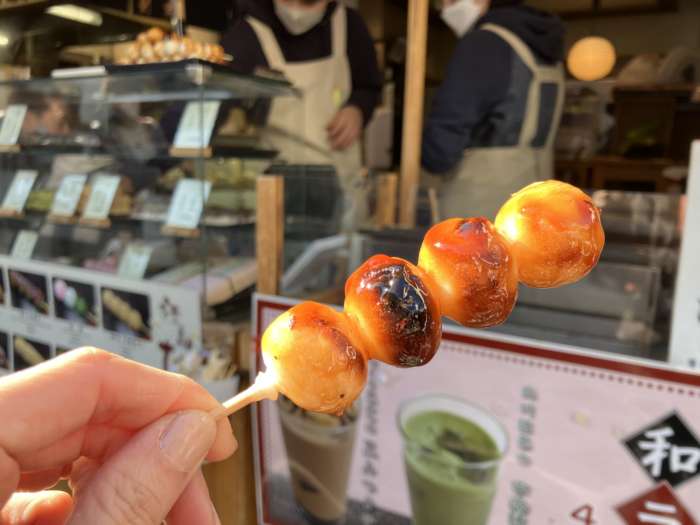
According to statistics from the Ministry of Internal Affairs and Communications, a family in Japan eats about 43 commercially made mochi (about 54 g each) per year.
Relater recipe :
! Caution !
The lower the temperature of mochi, the harder and stickier it becomes. Therefore, cut them into small, easy-to-eat pieces and drink tea or soup to moisten your throat before eating. Also, do not eat too much at once, but chew it well before swallowing.
Kissaten (Japanese Coffee Shop) 喫茶店
Do you all like to spend time relaxing in a cafe?
While there are many Western coffee chain stores in Japan, there are also traditional coffee shops called “Kissaten”(喫茶店). Kissaten is essentially a store that serves tea or coffee. However, Kissaten in Japan may be a little different.
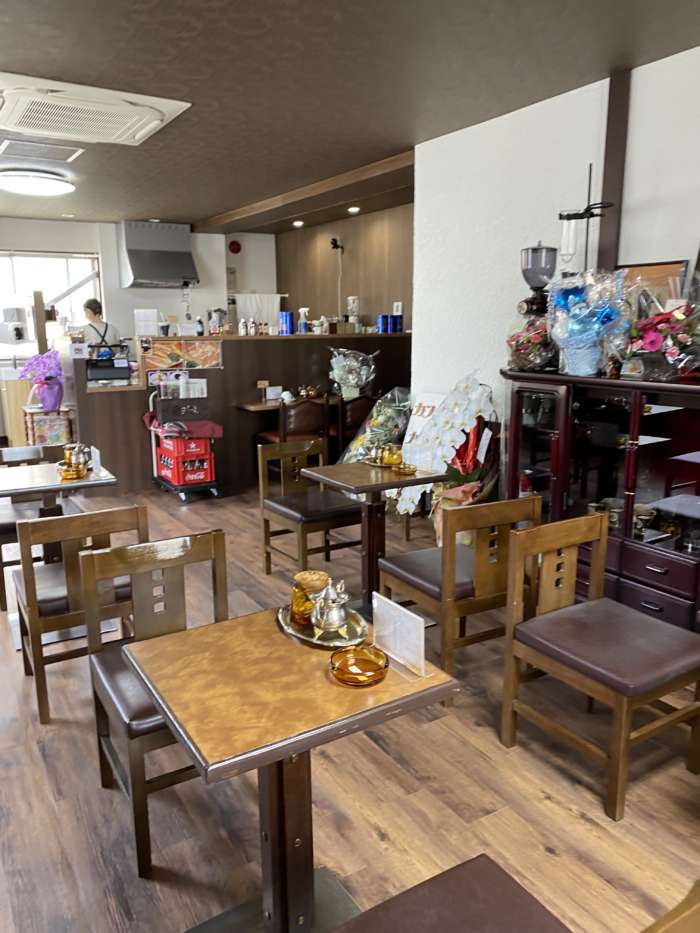 First, Kissaten are places to relax and quietly enjoy drinks and food. Some Kissaten have newspapers or magazines as well as TVs in the store, which may serve as background music in the store.
First, Kissaten are places to relax and quietly enjoy drinks and food. Some Kissaten have newspapers or magazines as well as TVs in the store, which may serve as background music in the store.
And, as is increasingly the case with Western coffee chains these days, Kissaten brew coffee one cup at a time, so it takes a little longer to be served. Still, it is worth the wait as a quality drink is served.
Read More
Bento 弁当
Bento is simply a Japanese meal that can be carried around. It usually comes in a plastic or wooden box with rice and a variety of side dishes (sometimes even fruit or dessert).
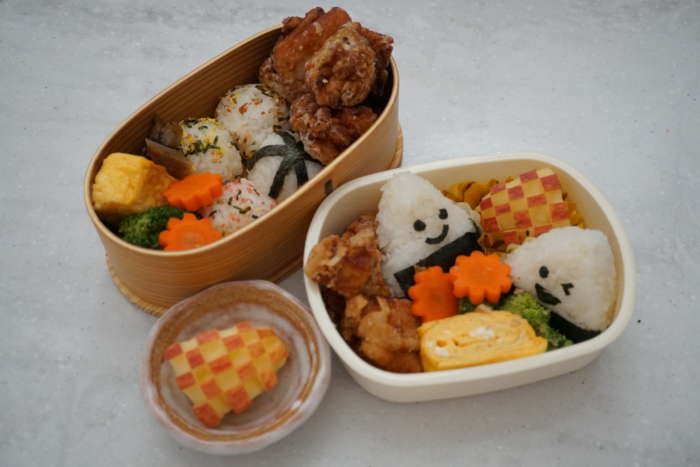
Bento is an essential part of Japanese culture. You can buy them at convenience stores, supermarkets, train station kiosks, and theaters. Homemade lunches are also a special way for school-going children and office workers to feel the love of their families. Bento is also a centerpiece of seasonal events such as cherry blossom viewing parties.
Composition of the Lunch Box
- Main Dish
- Side Dish
- Vegetable : This is it to fill in gaps in my lunches and to add colors.
- Japanese Rice : Sticky Japonica rice stays moist and delicious than other types of rice.
- Fruit : Apples cut into bite-sized pieces etc.
Popular Dishes of Bento
- Yaki-jake (Grilled salmon)
- Karaage (Japanese fried chicken) [Recipe]
- Tamagoyaki (Japanese omelette) [Recipe]
- Sausage/Wienerwurst
- Hijiki-ni (Simmered Hijiki Seaweed) [Recipe]
- Kiriboshi Daikon (Simmered daikon stripes) [Recipe]
Types of Bento
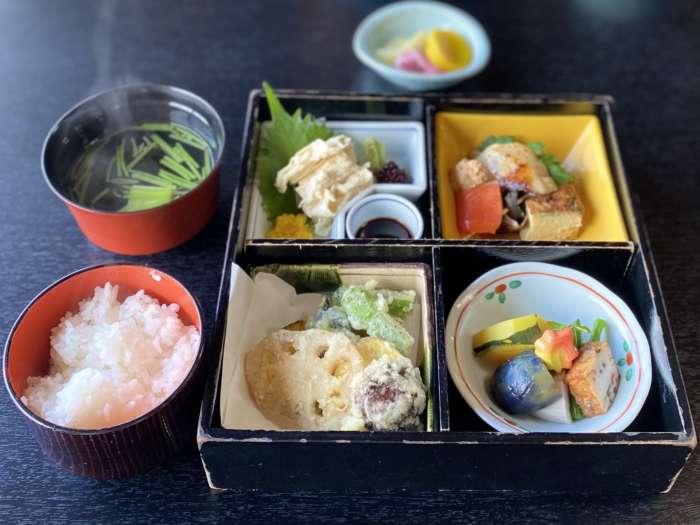
- Shokado Bento : Shokado bento is created by a kaiseki chef in Kyoto in the early 20th century. The bento box is divided into four compartments to separate tastes of each section. They say the divided structure of the box came from the container that was used by farmers to store seeds in 16th century.
- Makunouchi Bento : Makunouchi bento is probably the most classic bento. It was born as a meal eaten at theaters between acts during the Edo period. It contains well-balanced nutritious food. There are always small cylinder rice balls sprinkled with black sesame seeds in makunouchi. Pickled red plum may be on the rice balls to kill unwanted bacteria. The variation of taste, texture and colors make a bento delicious, enjoyable, satisfying and healthy.
- Ekiben/Railway Bento : Ekiben is one of the most enjoyable aspects of travel. You can enjoy bento boxes filled with local foods and specialties all over the country.
- Character Bento : Character bento, or charaben, is a bento box that features animals, characters from anime, manga or other cute images, such as panda, Totoro and Pikachu. Foreigners are highly impressed with how elaborately made they are. Originally these characters were introduced to bento to induce kids to eat their lunch. The prosperity of social media such as photo posting boosted the popularity of charaben in recent years. There are many tools available to help them, such as animal-shaped molds for rice, seaweed hole punches, and eyeball-shaped picks.
How to make your Bento less painful
- Keep utensils and lunch boxes clean : Wash your cooking utensils clean and wipe them dry. Spray the lunch box with sanitizing alcohol and let it dry.
- Drain off the liquid from the side dishes : Any remaining juices can cause spoilage. For side dishes with a lot of juice or vegetables with a lot of water, reduce the water content as much as possible before packing them, such as by pressing them down with a paper towel.
- Pack dishes after they have cooled : Freshly cooked rice and freshly prepared side dishes emit steam, so if you pack them as they are, they will steam in the lunch box and bacteria will easily grow. Allow them to cool before packing.
- Do not use your bare hands to make rice balls : To prevent germs from getting on the rice, wrap the rice in plastic wrap or wear plastic gloves to avoid direct contact.
- Use different chopsticks for cooking and serving : Raw meat and fish have a lot of bacteria on them. Prepare and use different chopsticks for packing the cooked dishes.
- Heat and reheat carefully : Meat, fish, and eggs should be cooked thoroughly to the inside. Processed foods such as ham, kamaboko (fish paste), and chikuwa (bamboo shoots) should also be reheated once during the hot season. It is inevitable that some bacteria will stick to leftover dishes, so be sure to reheat them and let them cool before packing them in the bento box.
- Remove the stems from fruits and vegetables : The stems of small tomatoes, strawberries, etc. may have dirt and germs on them. Be sure to remove the stems, wash them clean, and wipe them dry before putting them in the bento box..
- Add coolant : When the temperature is high, it is a good idea to place a coolant on top of the lunch box and wrap it in a cool bag to prevent it from getting damaged between the time you pack it in the morning and the time you eat it.
Related Articles
Memo :
1. Are you looking for Japanese kitchenwares and cooking tools? Please visit our online store!
2. Would you like to cook many more recipes? Download Free recipe app from here! “Recipe by YJC”
3. Reference of this article : 外国人がいちばん食べたい和食90選
Wagashi (Japanese Sweets) 和菓子
In today’s Japan, where many different food cultures come and go, wagashi is not in the spotlight as much as it used to be, but it still has a different appeal than western confectionaries that have been introduced from overseas.
Origin of Japanese sweets
There are some major events in the history of Wagashi. First, tea was introduced to Japan from China in the early 12th century, and wagashi became a part of tea ceremony over time.
In the 16th century, the Portuguese sugary sweets inspired the production of wagashi made with added sugar. During the Edo period, wagashi became more widely available to the public due to the increase of sugar imports. Until the Portuguese arrived in Japan, wagashi were naturally sweetened without sugar.
Difference from Yogashi (Western Sweets)
Unlike yogashi animal-based ingredients like dairy and eggs are not used to make wagashi. As a result, wagashi tends to be less fatty. On the other hand, wagashi often contains a lot of sugar. Also, wagashi is made by a variety of cooking methods beyond baking, such as steaming, kneading and molding.
Reflection of seasons
Wagashi is highly seasonal. Although many types of wagashi are available throughout the year, you can find unique wagashi items for each season. For example, pink colored wagashi is common in spring to represent the cherry blossom season. Wagashi with the shape and colors of autumn leaves are another popular item.
Varieties of Wagashi
- Dango (Rice Dumplings) 団子
Dango are small boiled dumplings made of rice flour. They are often served on bamboo skewers.
– Mitarashi dango (Dango coated with soy sauce and sugar sauce)
– Yomogi dango (Dango mixed with aromatic herb yomogi)
– An dango (Dango coated with sweet red bean paste)
– Kinako dango (Dango coated with sweet and dusty soy flour)
– Oshiruko (Dango in sweet red bean soup)
– Kurogoma dango (Dango coated with black sesame paste)
– Tsukimi dango *Dango eaten on the night of full moon in autumn to celebrate the harvest.
- Manju (Sweet Bun with Adzuki Bean Paste) 饅頭
Manju is type of wagashi typically stuffed with anko (sweet red bean paste), and also made with flour and steamed or baked.
– Saka manju *Yeast and koji mold are added to the dough.
– Ningyo yaki *Ningyo means doll.
– Kuri manju *Kuri means chestnut and it is filled with shiroan (sweet white kidney beans paste).
– Taiyaki *Sea bream shape manju
– Dorayaki *Anko sandwiched between small pancakes.
– Monaka *Anko packed inside a thin wafer.
Yoshoku (Japanese-style Western Food) 洋食
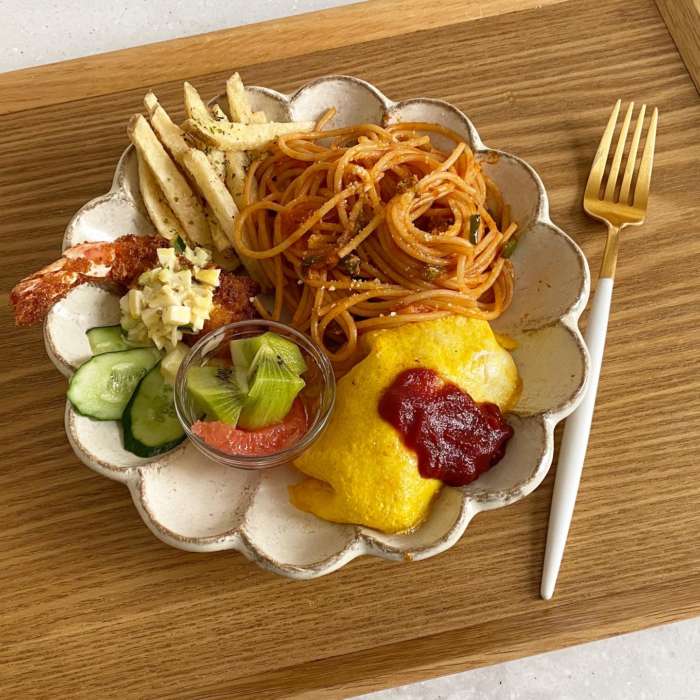
Yoshoku (洋食) is western food adapted to the Japanese palate. This style of cuisine started in the Meiji restoration period, 1868-1012, when, after centuries of isolation, Japanese citizens began traveling to other countries and learning about the cuisine outside of Japan. So, Yoshoku also means uniquely developed Japanese-style western dishes.
The classic Yoshoku dishes includes curry rice, ebi fry (fried shrimp), and Korokke (croquette made with potatoes and meat). Some of these influences are reflected in the popularity in Japan, of sauces such as ketchup or Worcestershire, as well as bread.
Yoshoku has a special appeal of nostalgia to the Japanese. It is an icon of the Showa period, and the never-changing taste of the classic dishes bring back people’s memories. A great place to feel the nostalgia is authentic Koshoku restaurants called “Yoshoku ya” (洋食屋) or “Yoshoku ten” (洋食店).
You can αlso eat Yoshoku dishes in other places, too. Family restaurants called “Famiresu” are casual and inexpensive chain restaurants. Okosama lunch is a popular item at famiresu. It is a plate of selected Koshoku dishes specially made for children. Some of the Japanese-style cafes called “Kissaten” (喫茶店) serve yoshoku dishes too.
Most Yoshoku dishes will be eaten with silverware instead of chopsticks, rice at Yoshoku restaurant is served on a plate instead of in a rice bowl.
Popular Yoshoku menu items:
Ebi Furai(エビフライ)Breaded and deep-fried shrimp [Recipe]
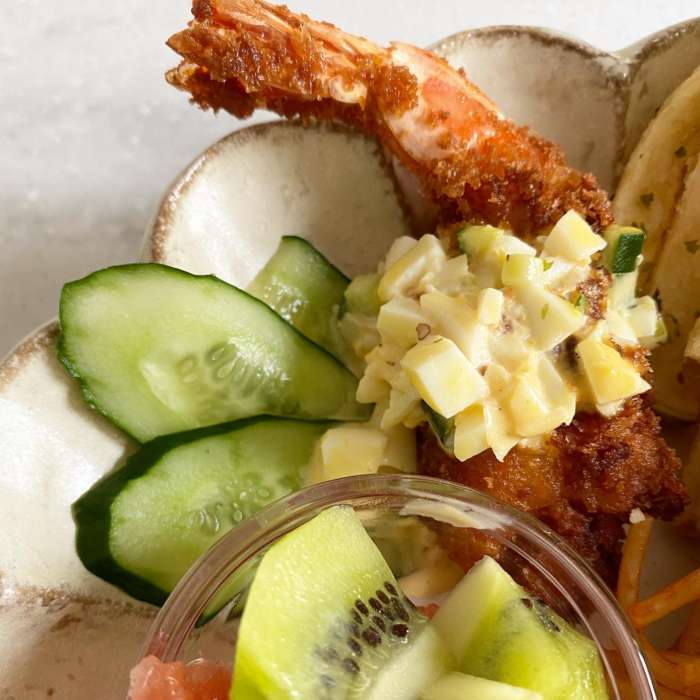
Napolitan (ナポリタン ) Spaghetti with ketchup based sauce [Recipe]
Napolitan is a classic Yoshoku dish made with spaghetti and a ketchup-based sauce. The sauce is typically is made with ketchup, onion, green pepper and mushrooms. Julienned ham, bacon or sausage is also added to the sauce.
It is normally served with grated parmesan cheese. The texture of the noodles is originally soft, but you can find firmer “al dente” nowadays.
It is said that this dish was invented after World War II by a chef in Yokohama who saw American soldiers eating spaghetti seasoned with ketchup instead of tomato sauce. Later, he improved the taste by using fresh tomatoes, and this legendary dish was born.
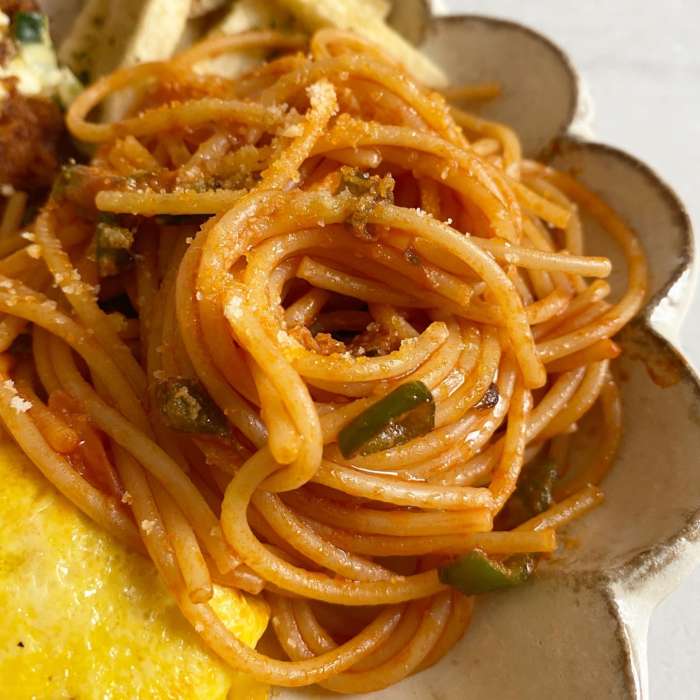
Omu rice(オムライス) An omelet willed with ketchup-flavored rice
Omu rice means “omelet and rice”. Flavored rice is wrapped in a thin sheet of omelet. It is shaped into an oval. Making a thin yet solid sheet of eggs is challenging for cooks. The rice is flavored with ingredients, such as chicken stock, onion, ketchup and butter. The sweetness of ketchup and onion complement the flavor of chicken.
Omu rice is also topped with ketchup. Cutting into the just-plated omu rice, you will enjoy the aroma coming out of the warm flavored rice inside.
There are variations of omu rice. The topping can be demi-glace sauce or bechamel sauce instead of ketchup. Omu curry is omu rice plated together with Japanese curry. Omu soba is noodles wrapped in a sheet of omelet instead of rice.
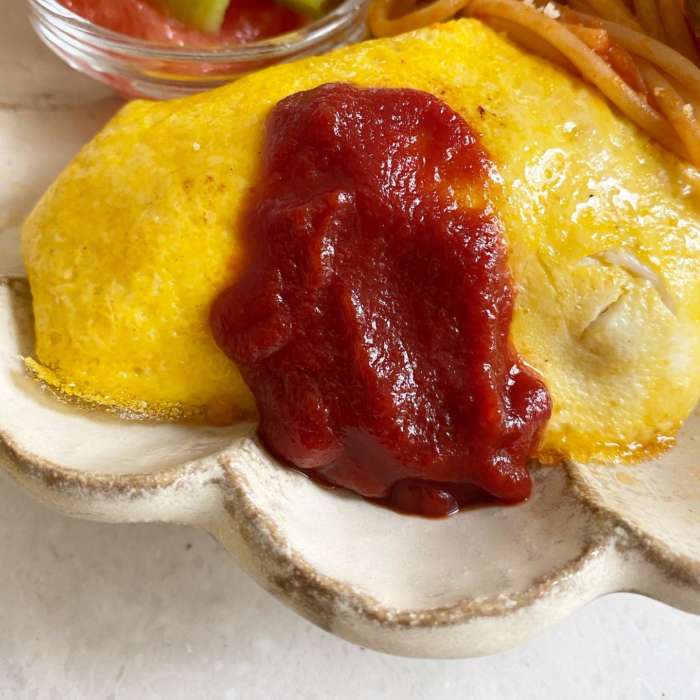
Hambagu(ハンバーグ)A meatloaf-like burger served with demi-glace sauce, but without a bun [Recipe]
Hambagu is a steak of a round or oval-shaped patty made with ground beef, onions, eggs and breadcrumbs. The meat may be a blend of beef and pork.
The name hambagu is said to have come from the dish made in the German city of Hamburg in 18th century. The original dish was brought to the US by German immigrants and became Hamburg steak. The Japanese eventually adopted it to their diet.
There are variety of sauces for hambagu. A blend of ketchup, oyster sauce and Worcestershire sauce is common. Other popular sauces include soy sauce and grated daikon radish, demi-glace and teriyaki. Hambagu may be topped with mushrooms, cheese, or a sunny-side egg. It is often served with rice or spaghetti.
Other Yoshoku menu items:
Kare-raisu (カレーライス) Curry with rice [Recipe]
Korokke (コロッケ) Creamy croquettes, sometimes filled with seafood such as crab
Menchi Katsu(メンチカツ) Breaded and deep-fried hamburger to which chopped onions have been added
Omuretsu(オムレツ) Omelet
Guratan(グラタン)Gratin dishes often macaroni or seafood in cream sauce with cheese
Doria (ドリア) Rice casserole with a white sauce
Hayashi raise (ハヤシライス) Beef stew in a demi-glace sauce
Bi-fu shichu (ビーフシチュー) Beef stew
Bi-fu sute-ki(ビーフステーキ) Beef steak
Roru kyabettsu(ロールキャベツ)Cabbage rolls with tomato sauce
Memo :
1. Are you looking for Japanese cookbooks and kitchenwares etc? Visit YJC store on Amazon!
2. Would you like to cook many more recipes? Download Free recipe app from here! “Recipe by YJC”
* Reference of this article : Food Sake Tokyo (The Terroir Guides) , 外国人がいちばん食べたい和食90選
Dashi (Japanese Soup Broth) だし
Dashi (だし) is the most important soup/broth to create the authentic Japanese palate. Umami-rich ingredients like kelp (Kombu), Bonito flakes, and dried sardines are all key ingredients of dashi.
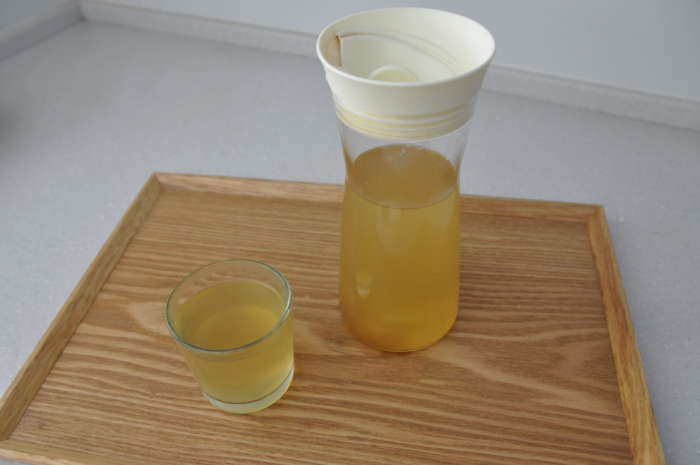
The most basic dashi, Ichiman (number-one) dashi is made from kelp and bonito flakes. In parts of Japan, Niboshi (dried sardines) are used instead of bonito flakes. Fried shiitake mushrooms and scallop ligaments can also be used in dash, as can the head and bones of sea bream (tai no are dashi).
Vegetarian dash can be made from kelp, along with dried shiitake mushrooms or other dried vegetables such as gourd (kanpyo), daikon (kiriboshi daikon), or soybeans (daizu).
The main ingredients of Dashi
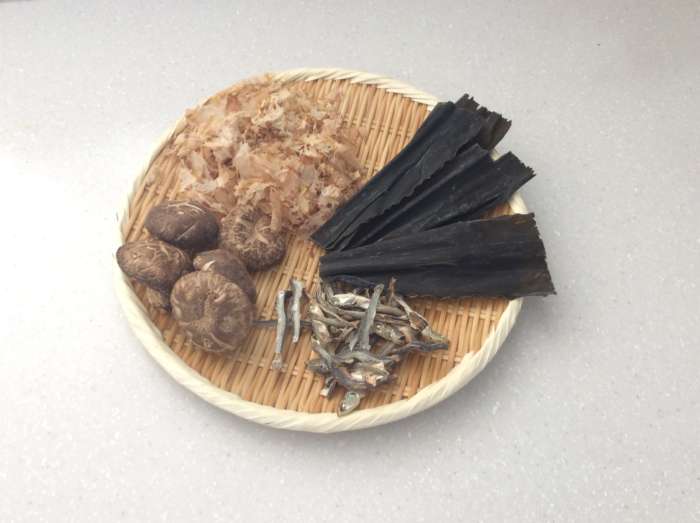
1. Kelp (Kombu 昆布) : The cold, mineral-rich waters surrounding Hokkaido provide 99.5% of the country’s kombu. Most kombu is sold in long strips. But it is also available in shavings (tor0ro or boor) to add to soup or sprinkle over the rice. Kombu can also be wrapped around was fish in a process called kobujime, which changes the fish’s texture and adds umami.
There are more than forty types of child and farmed kombu. The name of a specific variety of kombu often reflects where it was harvested. These are the five most popular:
Rishiri kombu (利尻昆布) : Harvested near Rishiri Island, this is an aromatic kombu that makes a clear broth, popular with chefs in Kyoto. It is considered a high-quality kombu and is often used in top restaurants.
Rausu Kombu (羅臼昆布) : This thick kombu has a stickiness to it, and a deep. Rich flavor that is slightly sweet. Also a high-quality kombu, it is the kombu that is used to make other shaved kombu products such as tororo and oboro.
Ma Kombu (真昆布) : Thick and rich in umami, slightly sweet, with an elegant flavor, this is also considered a top kombu.
Hidaka Kombu (日高昆布) : From the Hidaka region, this kombu is a popular variety used by busy home cooks because it quickly imparts its flavor when simmered in water. It is also reasonably priced and can be used as an ingredients for fish cake stew (oden), sea vegetables and seafood simmered in soy (Tsukudani) and other kombu dishes.
Naga Komnbu (長昆布) : A very long kombu (more than ten meters long), naga kombu is also used in dishes such as oden and Tsukudani. It is found only in the wild – not farmed- and is reasonably priced.
2. Bonito flakes (Katsuobuashi かつお節) : Dried and shaved bonito flakes, a key ingredients in dash, brings a smoky richness to the broth. It can be made from a variety of fish including yellowfin tuna, mackerel, and anchovies – each, of course, with its own flavor profile.
To make katsuobushi, the bonito is simmered and its bones are removed after which it is dried and smoked. Sometimes a mold that promotes fermentation is added to the bonito, other fish are processed in a similar fashion.
There are two major types of Katsuobushi:
Arabushi (荒節) : Light in flavor, this dried and smoked katsuobushi is the most popular type, especially in the Kyoto and Osaka region.
Karebushi (枯節) : A mold that promotes fermentation and imparts a stronger umami flavor is added to arabushi, resulting in this type of Katsuobushi, popular in the Tokyo region.
Different ways to shave fish flakes:
Atsu kezuri (厚削り) : Thick-cut shavings that make an intense dash, used in dishes that are simmered for a long time.
Hanakatsuo (花かつお) : Thinly shaved flakes used for making dash quickly
Hana kezuri (花削り) : Very thin shavings also used to make instant dashi
Ito kezuri (糸削り) : Thin strands often used as a garnish for tofu or vegetables
3. Dried Sardine (Niboshi 煮干し) : Small fish that are simmered in salty water and sun-feed before being used to make dash. Niboshi can be made from a variety of fish.
Popular types of Niboshi:
Katakuchi iwashi (片口鰯) : The most popular type of niboshi, made with anchovies; commonly used for making dash.
Ma iwashi (真鰯) : Made with pilchard, popular for soba or udon.
Urume iwashi (潤目鰯) : Low in fat, and odorless, this Iiboshi made with round herring makes a clear-colored dash popular in the Kyoto and Osaka region.
Tobiuo (飛魚) : Dashi made with the flying dish is slightly sweet and popular in the Nagasaki region.
Ma aji (真鯵) : Niboshi made with jack mackerel; results in a delicate and sweet dashi.
Tai (鯛) : Sea bream Iiboshi makes a delicate, elegant dash; found in dishes served at a Kaisei restaurant rather than at a neighborhood noodle shop.
4. Dried Shiitake (乾燥しいたけ) : It gives an earthy aroma, reminiscent of the forest floor, to dashi. It is particularly useful in vegetarian Shojin ryori .
Storage:
Those dried ingredients are available to keep in a dark and cool place for 6 months to 1 year.
Popular recipes that has Dashi:
– Miso soup with tofu and wakame
– Veggie Miso Soup
– Tonjiru
– Nasu Dengaku
– Daikon Dengaku Miso
and more…!
Memo :
1. Are you looking for Japanese kitchenwares and cooking tools etc? Visit YJC store on Amazon!
2. Would you like to cook many more recipes? Download Free recipe app from here! “Recipe by YJC”
* Reference of this article : Food Sake Tokyo (The Terroir Guides)
Japanese Food Words
Useful Words:
Amai : Sweet
Amakuchi : Sweet for beverages
Gochisosama (-deshita) : It was a feast (at the end of a meal)
Hashi : Chopsticks
Itadakimasu : Thank you for the food! (at the beginning of a meal)
Kanpai : Cheers (before drinking)
Karai : Hot or spicy
Karakuchi : Dry for beverages
Nama : Raw
Nigai : Bitter
Oishii : Delicious
Okawari : Refill
Osusume : Recommendation
Shoppai : Salty
Suppai : Sour
Evocative words:
Atsu atsu : Steaming hot, almost too hot to eat , like a hot pot
Fuwa fuwa : Fluffy, like a marshmallow
Gabu gabu : Drinking wholeheartedly
Hoka hoka : Hot, at just the right temperature, like a bowl of rice
Hoku hoku: Steamy, like baked potatoes
Jyu jyu : Juicy food being grilled
Kori kori : Crunchy, like a pickled daikon radish
Koto koto : Sound of a bubbling pot
Mochi mochi : Chewy, like mochi (rice taffy)
Neba Neba : Slimy and Sticky, like natto (fermented soybeans) or Tororo (grated yam)
Nuru nuru : Slimy and slippery, like a okra
Paku paku : Eating wholeheartedly
Pari pari : Thin and crispy, like a potato or nori seaweed chips
Piri piri : Something that is spicy, like too much wasabi or curry
Puri puri : Resistant, like fresh shrimp
Puru puru : Wiggly, like pudding or jelly
Saku saku : Delicate and crispy, like tempura
Shari shari : Sound of ice being shaved
Shiko shiko : Chewy, like a abalone or udon
Shuwa shuwa : Fizzy, like a sparkling water
Ton ton : The sound of a knife rhythmically hitting the cutting board
Toro toro : Melts in your mouth, like fatty tuna
Tsubu tsubu : Chunky bits, like the pulp in freshly squeezed orange juice
Tsuru tsuru : The sound of slurping noodles
* Reference of this article : Food Sake Tokyo (The Terroir Guides)
Onigiri (Rice balls) おにぎり
It is no exaggeration to say that rice balls are a national dish of Japan. There are various types of rice balls, from simple ones that are simply sprinkled with salt, to those that contain various fillings, and those that are made from grilled rice. Onigiri is evolving day by day and is not only the main character of bento, but also an easy-to-eat snack.
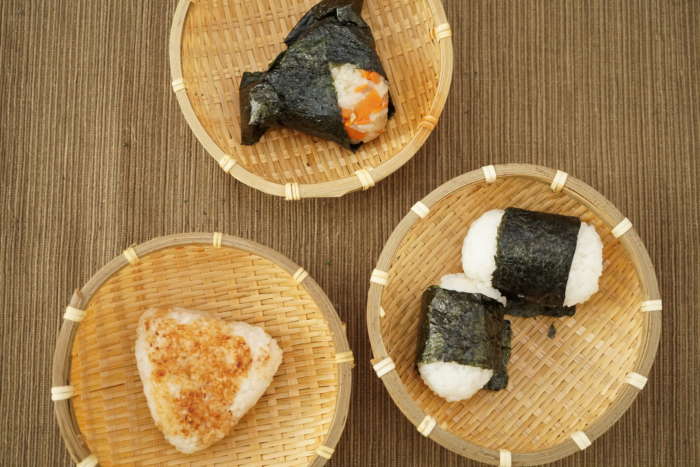
Onigiri is made by adding ingredients to cooked Japanese rice and molding it into a triangle, round shape, or bale shape.
My family also loves rice balls. In particular, simple salted rice balls that are simply sprinkled with salt and wrapped with seaweed are popular. At my home, rice balls appear not only for breakfast and lunch, but also when we have finished eating dinner and want to eat something a little more. So as we go on a picnic, we often bring rice balls with various fillings rather sandwiches.
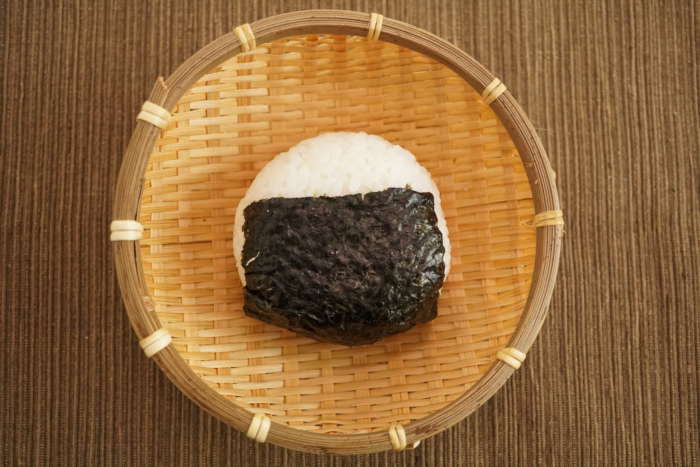
What is the difference with Onigiri and Sushi?
One of the key differences between onigiri and sushi is that onigiri is made with plain steamed japonica rice, while sushi is made of steamed japonica rice seasoned with vinegar, salt, and sugar.
On the contrary, what sushi and rice balls have in common is that they are dishes designed to preserve rice for a long time.
Rice vinegar is used for sushi. For onigiri, salt is sprinkled around rice balls, and antibacterial and preservative ingredients such as pickled plums and various pickles are often used.

Where you can buy Onigiri?
In general, you can buy rice balls at convenience stores and supermarkets in Japan. At convenience stores, not only standard ingredients but also unique rice balls made with seasonal ingredients are available. Although there are still few, there are rice ball specialty stores from individual stores to chains.
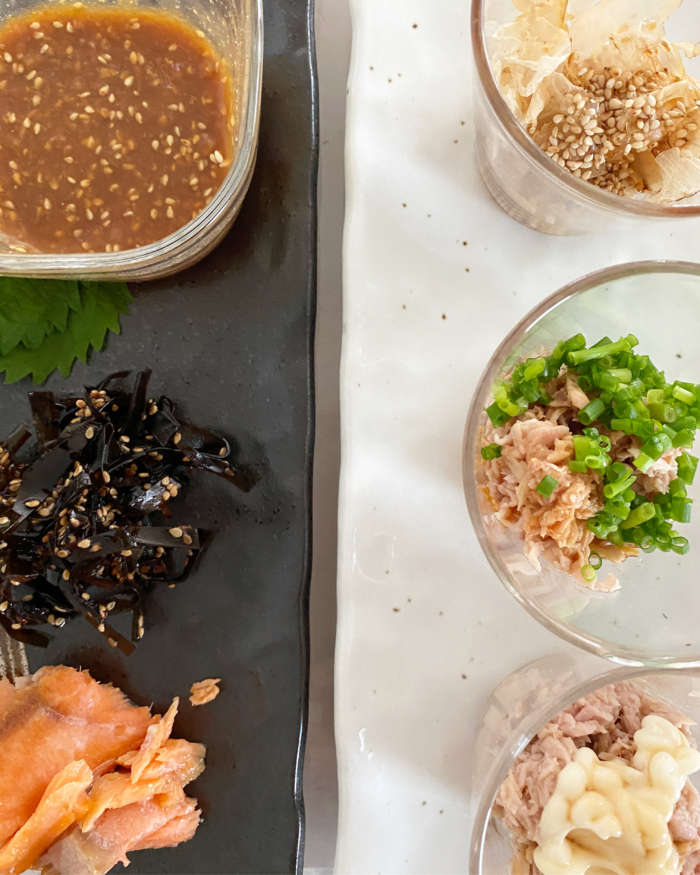
Traditional onigiri fillings
– Umeboshi (Pickled plum、梅干し)
– Sake (Grilled salmon、焼鮭)
– Kombu (Simmered kelp、昆布の佃煮)
– Tuna Mayo (Tuna mayonnaise、ツナマヨ)
– Mentaiko (Mentaiko、明太子)
– Cha-han (Fried rice、チャーハン)
– Yaki-onigiri (Grilled onigiri、焼きおにぎり)
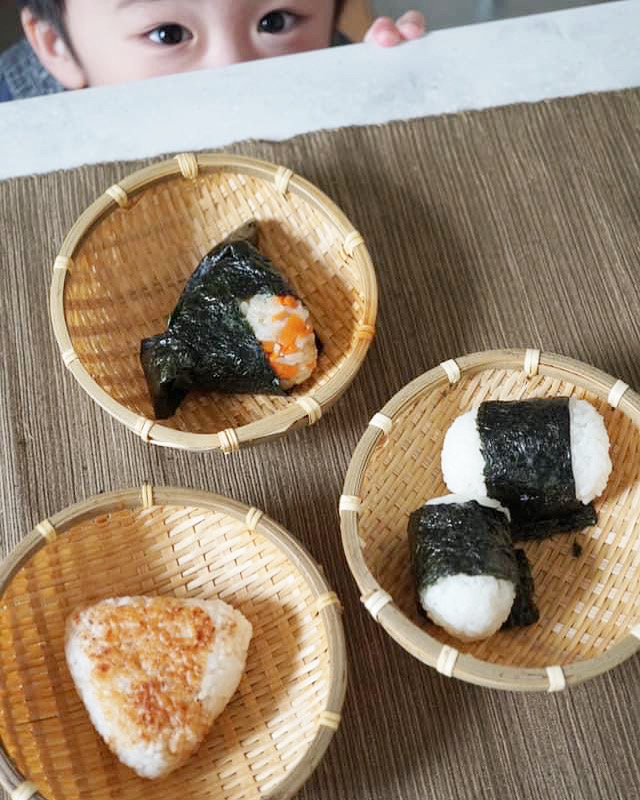
Let’s make various Onigiri!
– Okaka Onigiri [Recipe]
– Okaka Cheese Onigiri [Recipe]
– Salmon Onigiri [Recipe]
– Spicy Salmon Onigiri [Recipe]
– Tuna Mayo Onigiri [Recipe]
– Spicy Tuna Onigiri [Recipe]
– Kombu Onigiri [Recipe]
– Fried Rice Onigiri [Recipe]
– Grilled Onigiri Vol.1 [Recipe]
– Grilled Onigiri Vol.2 [Recipe]
– Red Bean Rice Onigiri [Recipe]
– Takikomi Gohan Onigiri [Recipe]
– Green Pea Onigiri [Recipe]
– Pork Miso Onigiri [Recipe]
– Nikumaki (Meat wrapped) Onigiri [Recipe]
– Dry Curry Onigiri [Recipe]
– Ume (Pickled Plum) Onigiri [Recipe]
Editor’s Note: This post was originally published on November 18, 2020.
Tsukemono (Japanese Pickles) 漬物
Japanese pickles are normally served with rice and miso soup. There is also a wide variety of Japanese pickles, from salt-only pickles to pickles using rice vinegar and sugar, and pickles using rice brans or rice koji. Japanese pickles play an important role in Japanese meals. Please see the world of Japanese pickles.
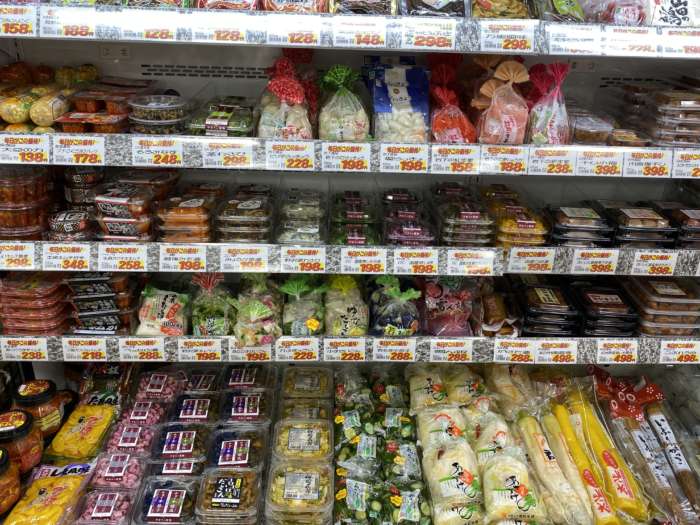
What is the characteristic of Japanese pickles ?
Tsukemono (Japanese Pickles, 漬物) – are preserved vegetables that are pickled in salt (or salt water), soy sauce, vinegar mixed with sugar, miso, sake lees, rice bran or rice koji. They are variously called Tsukemono, Kou no mono, or Shinko can be salty, sour, tart, piquant, or sweet.
Pickling time ranges from a few minutes to a few hours to a few years, and some pickles are fermented in the process. They also vary widely in texture: cucumber pickles are crispy, eggplant pickles are soft and may squeak in your teeth. Takuan, the popular yellow pickle made from dried daikon, is sweet and crunchy.
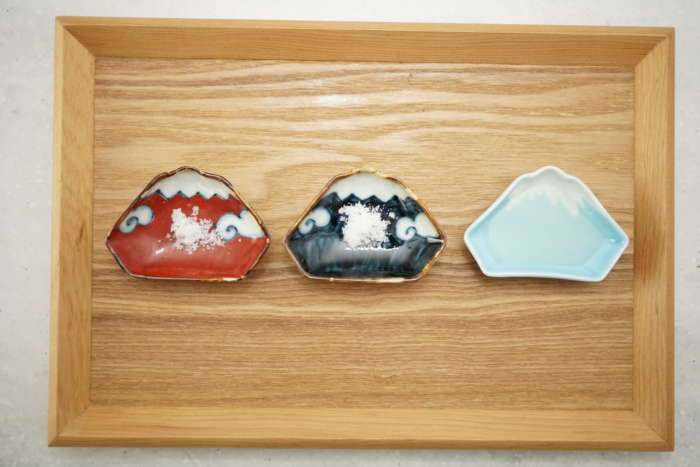
From the thin-sliced pickled ginger at the sushi counter to kaiseki meals that traditionally end with them, pickles are present in some form at most Japanese meals. Benishoga, or bright red pickkled ginger, is a popular accompaniment to fried noodles with vegetables called yakisoba. Curry is often served with sweet, red pickles made from seven different vegetables called fukujinzuke.
Some of the most distinctive pickled items are called Naraduke which originated in Nara, in the kansai region. These melon gourds, and other vegetables are pickled in sake kasu (sake lees) for as long as three years. Many of the melons and gourds arwe long, thin varieties, and after pickling, are presented in a spiral that resembles a sausage and covered in a brown slurry.
Another distinctive type of pickle, nukazuke, uses nuka (rice bran) as the fermenting agent. In the market the nuka looks like wet sand and covers whole pickled vegetables such as cucumbers, carrots, or daikon radishes. Before eating, the bran is rinsed off and the vegetables are cut up into bite-size pieces. The resulting aroma and flavor are quite different from pickles made with salt or vinegar. In Tokyo, local pickle bettarazuke: daikon pickled in rice koji slurry is popular.
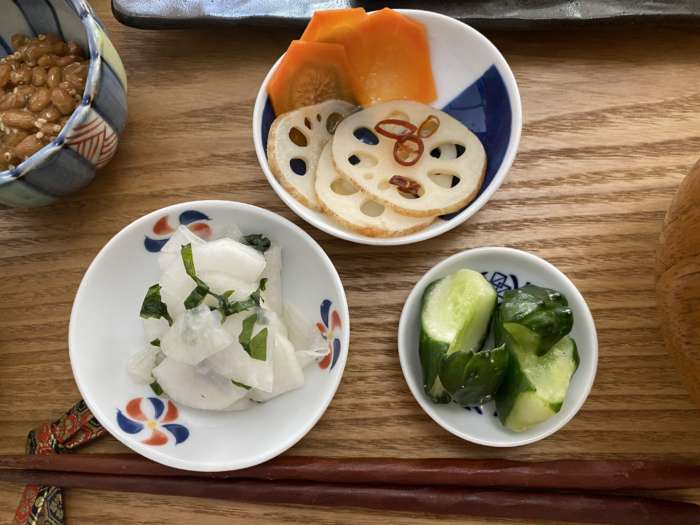
In Japan, it is usually served with various Japanese dishes, including Japanese breakfast, soba or udon noodles and donburi dishes. Pickles play an important role in balancing the whole dish, even though it is a small dish. For example, pickles have the effect of refreshing the mouth. For this reason, pickles are called konomono (Kou no mono, 香の物) or “fragrant things” or “fragrant foods” at long-established Japanese restaurants.
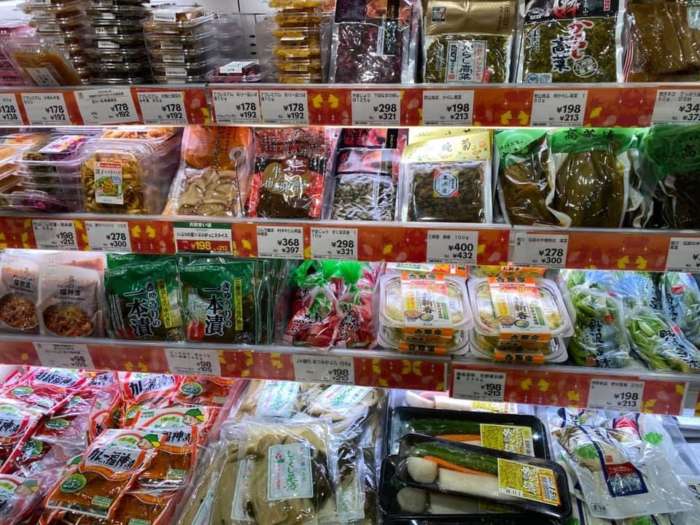
Best 3 Healthy Benefits
1. Vitamins
2. Antioxidant
3. probiotics = digestive system healthy
Top 10 Popular Japanese pickles
1. Shio-zuke (salted pickles, 塩漬け)
2. Umeboshi (Pickled plum, 梅干し)
3. Takuan (Pickled daikon, たくあん)
4. Shibazuke (Pickled in salt and red shiso leaves, しば漬け)
5. Asazuke (Lightly pickled vegetables, 浅漬け)
6. Nukazuke (Pickled vegetables in rice bran, 糠漬け)
7. Kasuzuke (Pickledvegetables in rice koji/mold, 粕漬け)
8. Shinshoga (Pickled ginger, 新生姜)
9. Rakkyo (Pickled Chinese onion, らっきょう)
10. Benishoga (Pickled and colored ginger, 紅生姜)
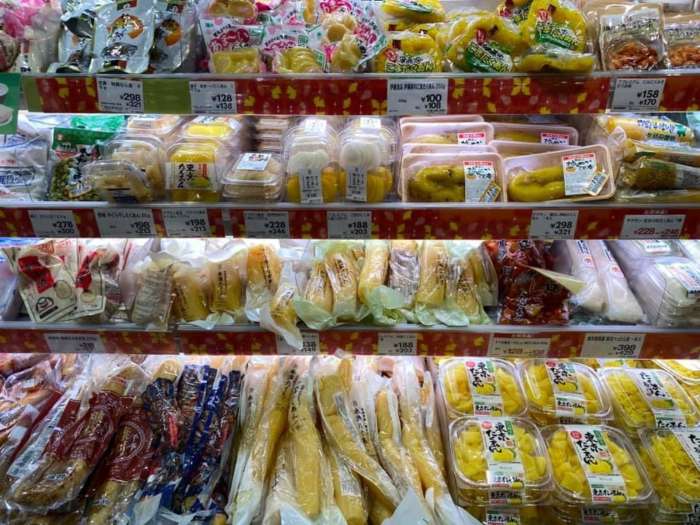
What are the popular vegetables for Japanese pickles?
– Cucumber(きゅうり)
– Daikon radish(だいこん)
– Eggplant(なす)
– Carrot(にんじん)
– Chinese cabbage(はくさい)
– Turnip(かぶ)
– Lotus root(れんこん)
– Chinese onioin(らっきょう)
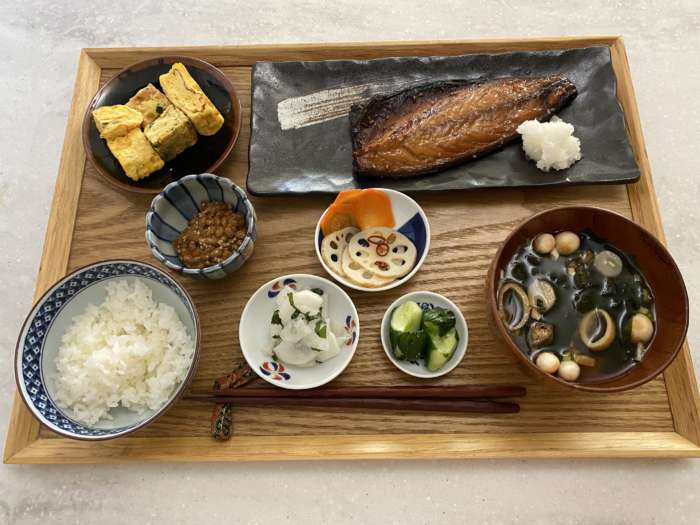
Watch How To Make Tsukemono
Recipe : Japanese Pickles
You might also like…
1. Cucumber and shiso pickles
2. How to cook Japanese rice with using pot
3. How to cook Japanese rice with using rice cooker
4. Miso soup
5. Veggie miso soup
Editor’s Note: This post was originally published on November 4th, 2020.
Tamagoyaki (Japanese Omelette/Egg Roll) 玉子焼き
Tamagoyaki (玉子焼き) is normally sweet and is popular not only as a side dish for lunch boxes and Japanese breakfast. Recently, it is used as a filling of sandwich.
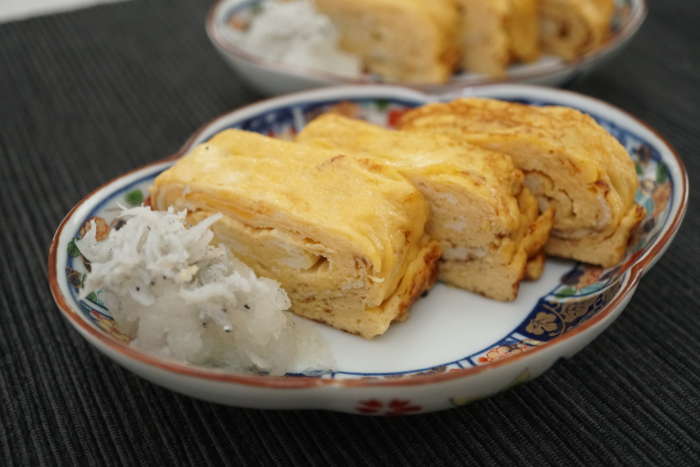
Tamagoyaki (玉子焼き) is a sweetened egg rolled omelette that has golden yellow color and unique shape. Yes, it’s like a pillow (before cutting!)
Tamagoyaki has both sweet and savory taste and is loved by young to the old here in Japan.
You might have tasted this Japanese style egg roll as a side dish in a bento box or as one of the appetizer of Japanese breakfast or atop of sushi.
Nowadays, you can see Tamagoyaki in a sandwich.
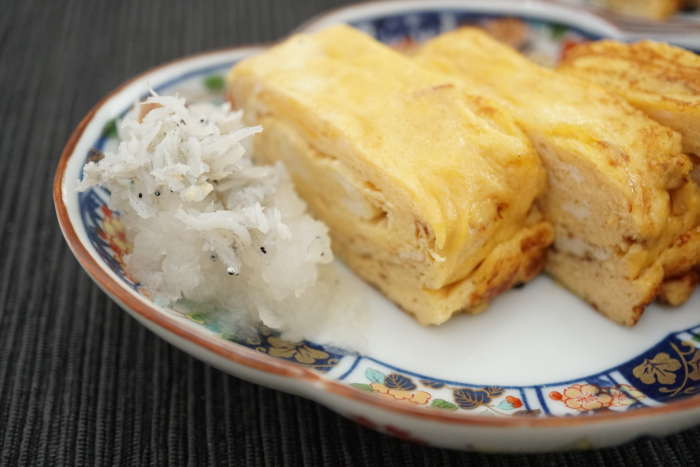
Tamagoyaki is rolled thin omelettes so that it has several layers. It looks easy and simple to make Tamagoyaki but making Tamagoyaki for the first time might be a littble bit tricky.
But no worries! You might need to practice a few times and you will soon be a Tamagoyaki master! (Please try some of my Tamagoyaki recipes!)
What is difference of Tamago (玉子) and Tamago (卵)?
Birds that are used for food (cooked) are called 玉子. Biological meaning such as fish and insects or that are eaten raw from birds are called 卵.
People also confuse about the names of Tamagoyaki(卵焼き), Atsuyaki Tamago(厚焼き玉子), and Dashimaki Tamago(だし巻き玉子).
– Tamagoyaki : Japanese omelette/Egg roll in general.
– Atsuyaki Tamago : thick egg roll with firm and dense texture
– Dashimaki Tamago : egg roll with dashi in it. It has much more refined, juicy, silky, and flavorful.
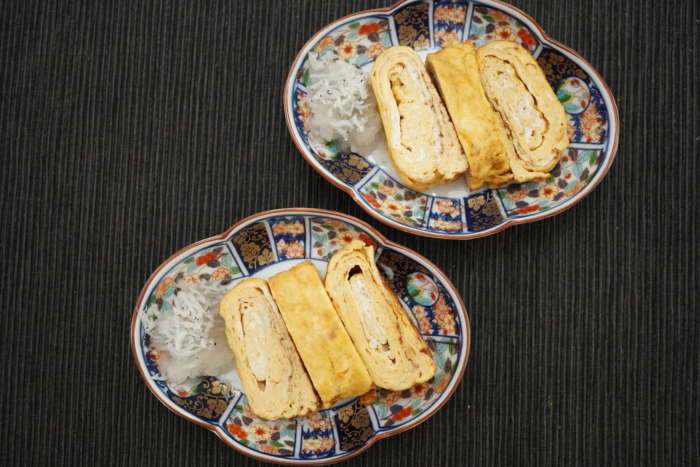
Arrangement
What is great about making Tamagoyaki at home is that you can create your own Japanese omelette. You can add various ingredients such as Shirasu (small fish), Nori seaweed, Sakura-ebi (dried small shrimps), green pepper or other veggies, salmon flakes and ground meat etc.
About Japanese omelette pan
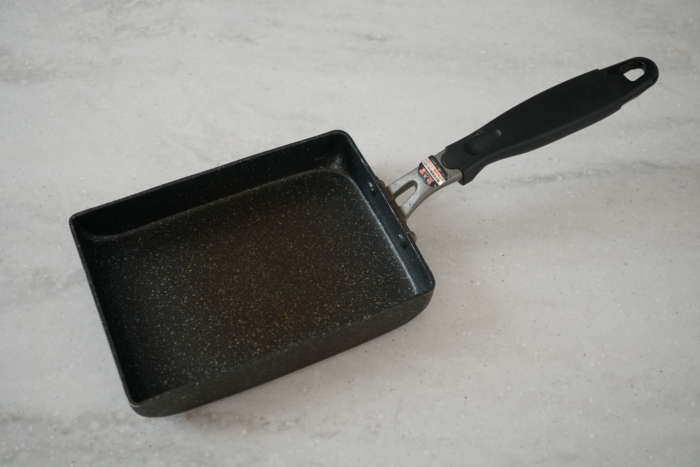
In Japan, there is a special pan designed for making this egg roll. It’s also curious that rectangular shape pan is common in Kansai (West Japan) and square shape pan is common in Kanto (East Japan).
How to make Tamagoyaki?
Recipe : Tamagoyaki (with Omelette Pan & Round Pan)
Recipe : Tamagoyaki (Japanese Omelette/Egg Roll)
You might also like…
1. Tamagoyaki (Japanese Omelette/Egg Roll) with Mayonnaise
2. Tamago Sando
3. Seasoned Egg
Editor’s Note: This post was originally published on August 4th, 2013. The post has been updated in October 27, 2020 with more information for the dish and with new images.





































